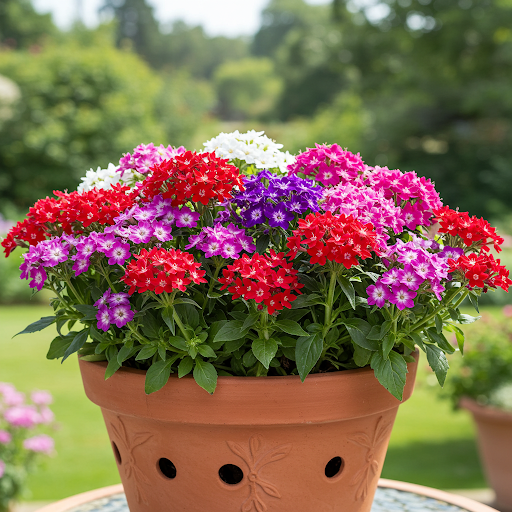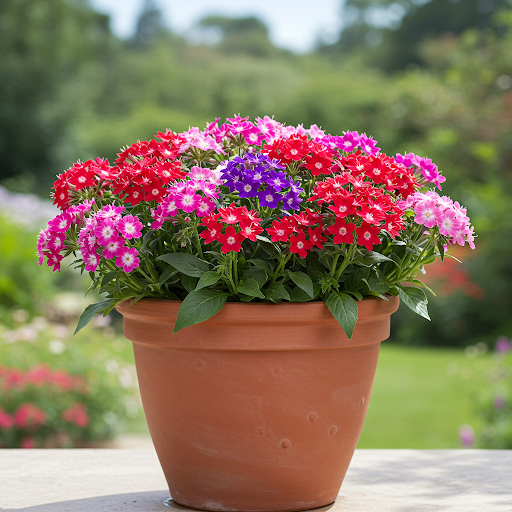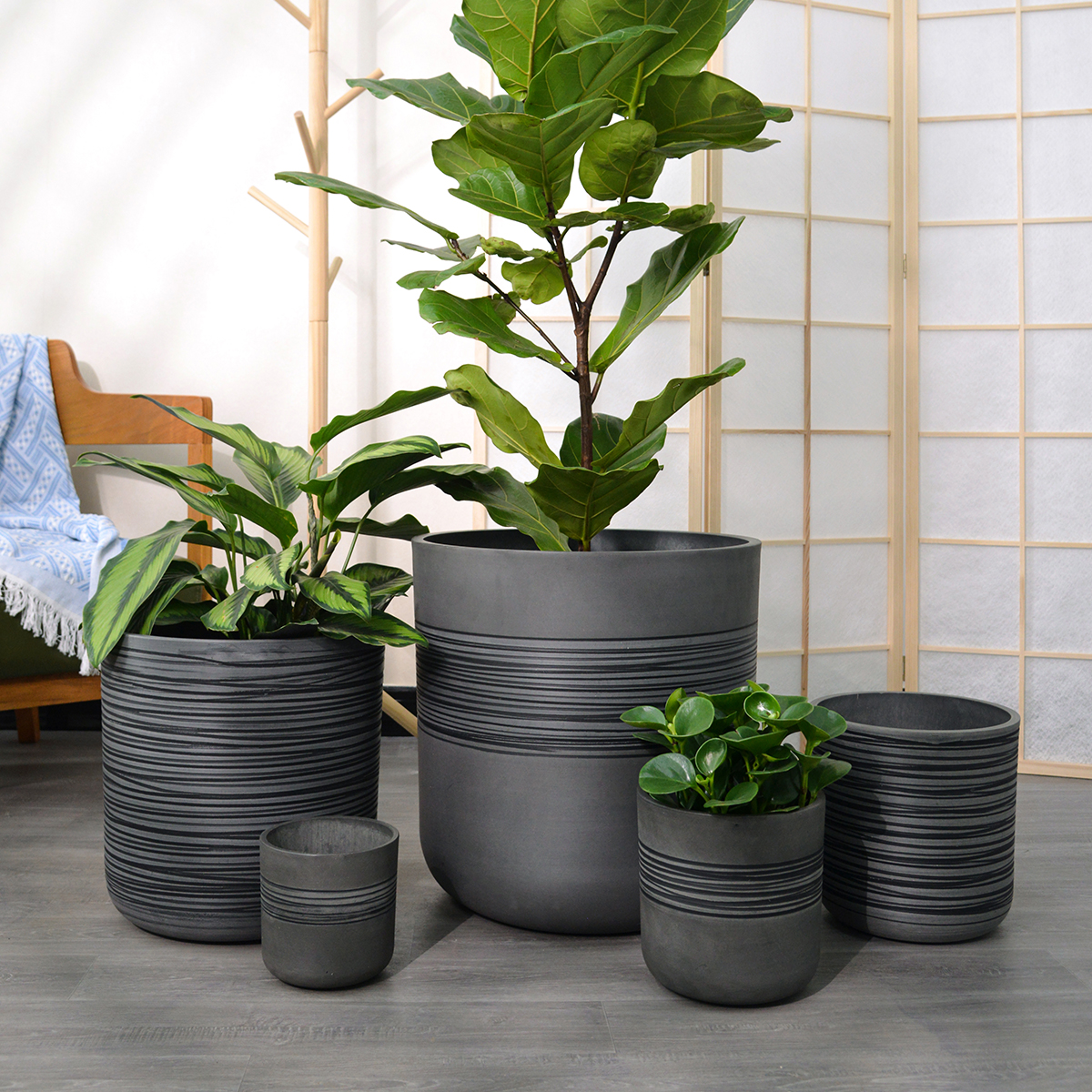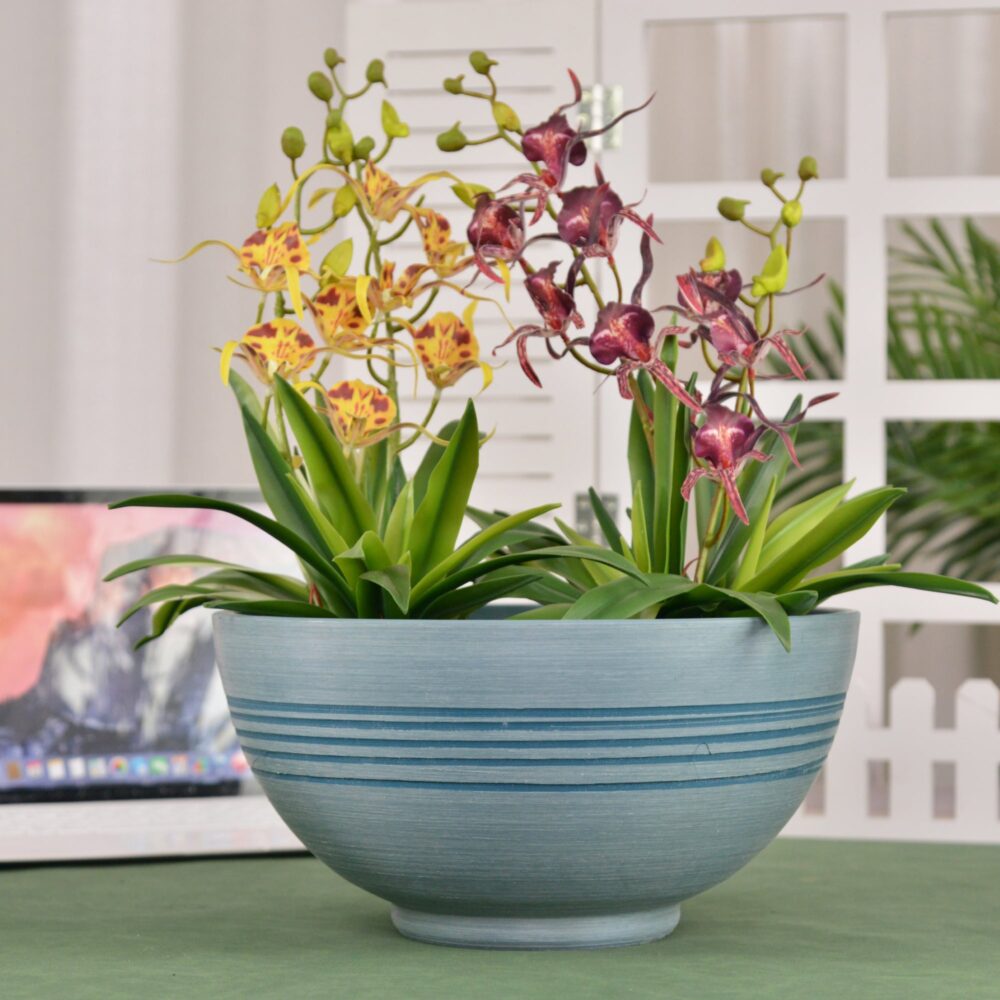Pentas in Pots: The Complete Guide to Growing Star Clusters Outdoors in Containers
Want to attract butterflies and hummingbirds to your patio, balcony, or garden with clusters of star-shaped, colorful flowers all summer long? Pentas, commonly known as Star Cluster or Egyptian Starflower, is an incredibly easy and rewarding choice for outdoor container gardening. Celebrated for their long-lasting displays of star-shaped flower clusters in shades of pink, red, purple, lavender, and white, and their attractiveness to pollinators, Pentas are perfect for adding low-maintenance beauty to sunny outdoor spaces. This comprehensive guide will provide you with everything you need to know to grow Pentas successfully in outdoor pots, from selecting the best varieties and containers to mastering essential care techniques for a season filled with Star Cluster charm.

Pentas
What are Pentas (Star Clusters)?
Pentas, commonly known as Pentas or Star Cluster, is a genus of flowering plants in the Rubiaceae family (coffee family). Native to tropical Africa, Madagascar, and the Arabian Peninsula, Pentas are popular annuals and perennialsgrown for their abundant clusters of small, star-shaped flowers and long blooming season. Pentas flowers are famous for their clusters of star-shaped florets, typically in shades of pink, red, purple, lavender, and white. The flower clusters are usually rounded or dome-shaped, composed of many individual, five-pointed star-shaped florets. Pentas plants exhibit diverse growth habits, from compact and bushy to upright and slightly spreading, ranging in height from under a foot to over 4 feet tall, depending on the species and variety. They are known for their delicate star-shaped flowers, exceptionally long blooming season (spring to frost), heat tolerance, sun-loving nature, and strong attractiveness to butterflies, hummingbirds, and other pollinators, making them an invaluable addition to gardens and containers, especially for adding continuous summer color and attracting wildlife.
Are Pentas (Star Clusters) Good for Outdoor Pots?
Yes, Pentas (Star Clusters) are exceptionally well-suited for outdoor pots and container gardening. Their exceptionally long blooming season, heat tolerance, adaptable growth habits, and attractive, star-shaped flower clusters make them ideal for filling pots, window boxes, and mixed container arrangements with delightful, pollinator-friendly blooms. Pentas thrive in sunny locations and bloom profusely throughout the warm season, providing an exceptionally long-lasting and cheerful floral display in containers. Their relatively low-maintenance nature and striking, pollinator-attracting blooms make them a fantastic and rewarding choice for container gardens of all styles, especially for adding vibrant color to patios, balconies, and decks. Growing Pentas in pots also allows you to easily move them to optimal locations and control their growing conditions, especially drainage, which is important in cooler, wetter climates.
Ideal Growing Conditions for Pentas in Pots:
Types of Pentas for Pots: Many Pentas varieties are excellent for pots, but consider your desired growth habit, flower color, and size when choosing:
- Dwarf Pentas: (Pentas lanceolata dwarf types, Pentas varieties dwarf cultivars) – Compact and smaller in stature, typically under 1 foot tall and wide. Ideal for small pots, miniature gardens, window boxes, and edging. Known for their very compact, bushy habit and profusion of smaller flower clusters. Excellent for creating dense, colorful displays in small containers and for tight spaces. Look for varieties like ‘ স্টারcluster Series’, ‘ граффити Series’, ‘ HoneyCluster Series’, and ‘Butterfly Series Compact’.
- Compact Pentas: (Pentas lanceolata compact types, Pentas varieties compact cultivars) – Bushy and more upright, but remaining relatively compact, typically 1-2 feet tall and wide. Suitable for small to medium pots, mixed containers, and general garden use. Offer a wide range of colors and a rounded, mounded habit. Look for varieties like ‘Butterfly Series’, ‘ Kaleidoscope Series’, ‘New Look Series’, and ‘ Falling Star Series’.
- Medium-Sized Pentas: (Pentas lanceolata standard types, Pentas varieties medium cultivars) – More upright and slightly spreading growth, reaching 2-3 feet tall and wide. Best suited for medium to large pots, as thrillers in mixed containers, and for general garden use. Offer a good balance of height and flower power. Look for varieties like ‘ утёс Series’, ‘ Lucky Star Series’, ‘ Northern Lights Series’, and ‘ พันธุ์ผสม’.
- Upright Pentas: (Pentas lanceolata taller types, Pentas varieties taller cultivars) – More upright and shrub-like growth, reaching 3-4 feet tall or more in warmer climates, but can be kept smaller in pots with pruning. Best suited for larger pots as focal points or back-of-container plants in mixed arrangements. Choose taller varieties for larger pots or for a backdrop in mixed containers. Regular pruning can help maintain a desired size and shape in pots.
- Trailing Pentas: (Pentas lanceolata trailing types, Pentas varieties trailing cultivars) – Naturally trailing and spreading habit, typically under 1 foot tall but spreading 2-3 feet wide. Ideal for hanging baskets, window boxes, and cascading over the edges of pots. Known for their cascading growth and profusion of smaller flower clusters. Excellent for creating overflowing, colorful displays in hanging baskets and containers. Look for varieties like ‘Trailing Lavender’, ‘Trailing White’, and ‘ Фонтан Series’.
- Novelty Colors & Forms: (Bi-colors, picotee edges, star-shaped florets in unique shades) – Beyond the classic pinks, reds, purples and whites, explore varieties with bi-colored florets, picotee edges, or unique shades within the typical Pentas color palette. Many newer Pentas cultivars offer subtle variations and interesting flower patterns. Look for varieties with bi-color or picotee descriptions in their names.
Light: Pentas thrive in full sun to partial shade. In most climates, they perform best in full sun, needing at least 6 hours of direct sunlight per day to bloom profusely and maintain vibrant colors and healthy, compact growth. In very hot, intense summer climates, especially in the afternoon, partial shade during the hottest part of the day can be beneficial to prevent leaf scorch and prolong bloom time. Choose a location that offers either full sun or morning sun with afternoon shade for your Pentas containers. In too much shade, Pentas will produce fewer blooms, become leggy, and colors may be less intense.
Soil: Pentas need well-draining soil that is rich in organic matter and slightly acidic. Use a high-quality potting mix specifically formulated for containers or flowers. Amend potting mix with compost, peat moss, or coco coir to improve drainage, aeration, and nutrient content. Pentas prefer consistently moist, but not soggy, soil. Avoid heavy, compacted soil or garden soil in pots, as they can become waterlogged. A slightly acidic to neutral pH (around 6.0-7.0) is ideal for Pentas. Good drainage is crucial to prevent root rot, but they appreciate slightly richer soil than some other drought-tolerant container plants.
Watering: Pentas prefer consistently moist soil, especially during active growth and blooming periods, but they do not like to be waterlogged. Water thoroughly when the top inch of soil feels slightly dry. Water deeply until water drains out of the drainage holes. Maintain even soil moisture, but avoid letting pots sit in standing water. Do not allow the soil to completely dry out, especially in hot, sunny, or windy weather, as this can stress plants and reduce flowering. Watering frequency will depend on weather conditions, light levels, pot size, and plant size. During hot summer months, you may need to water daily or even twice a day for smaller pots in full sun. Check soil moisture regularly and adjust watering accordingly. Water at the base of the plant to keep foliage and flowers dry and help prevent fungal diseases.
Temperature: Pentas are warm-weather plants that thrive in warm temperatures. They perform best in temperatures between 65°F to 85°F (18°C to 29°C). They are very heat-tolerant and bloom most profusely in warm summer conditions. Pentas are frost-tender and are typically grown as annuals in most climates (USDA zones below 10). In USDA zones 10-11, some Pentas varieties can be perennials and may overwinter outdoors in protected locations. Potted Pentas are easy to move indoors to protect from frost in colder zones if you wish to overwinter them. They do not tolerate frost or freezing temperatures.
Fertilizer: Pentas are moderate feeders and benefit from regular fertilization to support their long blooming season and abundant flower production. Fertilize regularly during the growing season (spring to fall) with a balanced liquid fertilizer (e.g., 10-10-10 or 20-20-20) diluted to half strength, every 2-4 weeks. Alternatively, you can use a slow-release granular fertilizer incorporated into the potting mix at planting time, and supplement with liquid fertilizer as needed. Regular fertilization encourages continuous blooming and vibrant flower colors. Avoid over-fertilizing, which can lead to leggy growth and salt buildup in pots.
Choosing the Right Pots for Pentas:
Suitable Pot Types: Pentas are adaptable to various pot types, including terracotta, ceramic, plastic, resin, and hanging baskets. Consider these factors when selecting pot types for Pentas:
- Terracotta Pots: Porous, allow good aeration and drainage, and aesthetically classic. Terracotta is a good choice for Pentas as it provides good drainage and aeration, helping to prevent overwatering. However, terracotta pots also dry out more quickly, so monitor soil moisture, especially in hot weather and for moisture-loving plants like Pentas.
- Ceramic Pots: Available in many decorative styles, can add a decorative element to your container garden, and retain moisture reasonably well. Ensure good drainage. Choose based on your desired aesthetic and moisture retention needs. Glazed ceramic pots retain moisture better than unglazed terracotta.
- Plastic Pots: Lightweight, inexpensive, retain moisture well, and are available in various colors and styles. Excellent choice for Pentas, especially for moisture retention in sunny locations, and for larger pots that need to be moved. Choose good quality plastic pots with drainage holes. Lighter colored plastic pots may heat up less in direct sun.
- Resin Pots: Lightweight, durable, available in various styles mimicking terracotta or ceramic, and offer a balance of drainage and moisture retention. A good alternative to heavy ceramic pots, and often more durable than terracotta or plastic.
- Hanging Baskets: Ideal for trailing Pentas varieties, allowing them to cascade beautifully. Choose hanging baskets with good drainage and sufficient depth to accommodate root growth. Line wire baskets with coco coir or sphagnum moss liners to help retain moisture and improve water retention.
Drainage: Good drainage is essential for Pentas to prevent root rot. Ensure your chosen pot has drainage holes at the bottom. Avoid pots without drainage holes. Adding a layer of gravel or pot shards at the base of the pot is generally not necessary if using a well-draining potting mix, but can be done for extra precaution, especially in heavier pots. Elevating pots slightly on pot feet or bricks can further improve drainage and air circulation around the base.
Pot Size: Choose pot sizes appropriate for the type and mature size of the Pentas you are planting, and the desired display. Pentas have fibrous root systems and need adequate space for healthy growth.
- Dwarf Pentas: For dwarf Pentas, pots that are 6-8 inches in diameter and at least 6 inches deep are suitable for individual plants. For mass plantings or window boxes, use larger containers or window boxes with spacing of about 6-10 inches between plants.
- Compact Pentas: For compact Pentas, pots that are 8-12 inches in diameter and at least 8 inches deep are suitable for individual plants. For fuller displays or mixed plantings, use pots that are 12-16 inches or larger, or larger tubs.
- Medium-Sized Pentas: For medium-sized Pentas varieties, use pots that are 12-16 inches in diameter or larger and at least 10-12 inches deep for individual plants, or larger tubs or raised beds for multiple plants. Medium-sized Pentas need more root space and stability.
- Trailing Pentas: For trailing Pentas, hanging baskets or pots that are 10-14 inches in diameter and at least 8 inches deep are suitable for allowing good cascading growth.
Color and Style: Choose pot colors and styles that complement your Pentas blooms and your outdoor décor. Brightly colored pots can enhance the vibrant flower colors of Pentas. White pots can create a clean and classic look, allowing the flower colors to pop. Pastel-colored pots can complement softer Pentas shades like lavender and pink. Neutral pots in gray, black, or terracotta can provide a versatile backdrop and allow the Pentas flower colors and star shapes to stand out. Consider the overall style of your patio or garden and choose pots that harmonize with the surroundings.
Essential Care Tips for Thriving Pentas in Outdoor Pots:
- Watering: “Keep Soil Consistently Moist, Avoid Drying Out”. Water thoroughly when the top inch of soil feels slightly dry. Water deeply until water drains from drainage holes. Maintain even soil moisture, but avoid soggy conditions. Do not allow soil to completely dry out, especially during hot weather. Water more frequently during hot, sunny, or windy weather, especially for young plants and during peak bloom.
- Sunlight: Provide Full Sun to Partial Shade (6+ Hours Daily). Place Pentas pots in a location that receives full sun for best blooming and vibrant colors, or partial shade in very hot afternoon sun.
- Fertilizing: Fertilize Regularly During Growing Season. Fertilize every 2-4 weeks with a dilute balanced liquid fertilizer, or use slow-release fertilizer at planting time. Regular feeding promotes continuous blooming.
- Deadheading (Self-Cleaning, Minimal Deadheading Needed): Pentas are generally self-cleaning and spent flower clusters will typically dry and fall off on their own. Minimal deadheading is needed. If desired, you can lightly trim off spent flower clusters to maintain a tidier appearance, but it is not essential for reblooming.
- Pruning (To Shape & Encourage Bushiness): Pentas can be pruned to shape plants, control size, and encourage bushier growth. Pinch back stem tips of young plants to encourage branching. Lightly trim back plants if they become leggy or overgrown. More significant pruning is best done in late winter or early spring if overwintering.
- Overwintering (Protect from Frost in Cold Climates): In colder USDA zones where Pentas are not hardy, potted Pentas can be overwintered indoors. Before the first frost, move pots to a bright, cool location such as a sunroom or indoors near a sunny window. Reduce watering significantly during winter dormancy, watering only sparingly to prevent the soil from completely drying out. In spring, after the last frost, gradually acclimate plants back to outdoor conditions before placing them back in their sunny summer location.
- Pest and Disease Control: Pentas are generally relatively pest and disease-resistant, but monitor for occasional pests like aphids, spider mites, and whiteflies. Fungal diseases like powdery mildew or root rot can occur, especially in humid conditions or with overwatering. Ensure good air circulation by spacing plants adequately, avoid overcrowding, water at the base of the plant, provide good drainage, and avoid overwatering. Treat any pest or disease issues promptly with insecticidal soap, horticultural oil, neem oil, or appropriate fungicides if necessary.
Popular Pentas Cultivars for Pots (by Growth Habit/Color/Size):
- Dwarf Pentas: ‘ স্টারcluster Red’ (red dwarf), ‘ граффити Lavender’ (lavender dwarf), ‘ HoneyCluster Pink’ (pink dwarf), ‘Butterfly White’ (white dwarf), ‘Mini Series’ (various dwarf colors)
- Compact Pentas: ‘Butterfly Deep Rose’ (rose-pink compact), ‘ Kaleidoscope Appleblossom’ (pink and white bi-color compact), ‘New Look Red’ (red compact), ‘ Falling Star Lavender’ (lavender compact), ‘Bandana Series’ (various compact colors)
- Medium-Sized Pentas: ‘ утёс Rose’ (rose-pink medium), ‘ Lucky Star White’ (white medium), ‘ Northern Lights Lavender’ (lavender medium), ‘ พันธุ์ผสม Pink’ (pink medium), ‘Giant Series’ (various medium to tall colors)
- Upright Pentas: Pentas lanceolata (species, various colors, can be taller), ‘ граффити Lipstick’ (red tall), ‘Butterfly Dark Red’ (red tall), ‘HoneyCluster Red’ (red tall), ‘Tall Mix’ (mixed tall colors)
- Trailing Pentas: ‘Trailing Lavender’ (lavender trailing), ‘Trailing White’ (white trailing), ‘ Фонтан Pink’ (pink trailing), ‘Trailing Rose’ (rose-pink trailing), ‘Trailing Mix’ (mixed trailing colors)
- Novelty Colors & Forms: ‘Picotee Series’ (bi-color picotee edges), ‘ பட்டாம்பூச்சி Deep Pink Picotee’ (pink bi-color), ‘ விங்க்ஸ் Fuchsia Picotee’ (fuchsia bi-color), ‘ பிளாஷ் Forward Pink’ (bright pink early blooming), ‘ சுழல் Series’ (unique floret shapes)
- Seed Mixes: ‘Mixed Colors Pentas Seeds’, ‘Butterfly Garden Seed Mix (Pentas blend)’, ‘Pollinator Flower Seed Mix (Pentas included)’

Pentas
In Summary:
Growing Pentas (Star Clusters) in outdoor pots is a wonderfully rewarding way to add masses of vibrant, long-lasting color and attract butterflies and hummingbirds to your patios, balconies, and gardens. Their exceptionally long blooming season, diverse colors and habits, heat tolerance, and relatively easy-care nature make them a perfect choice for container gardeners seeking cheerful, pollinator-friendly plants that thrive in sunny locations. By providing full sun to partial shade, rich and well-draining potting mix in pots with drainage, watering to maintain consistent soil moisture, fertilizing regularly during the growing season, and providing minimal care, you can easily cultivate thriving Pentas plants in pots and enjoy their vibrant Star Cluster charm from spring until frost, year after year as annuals, or as cherished overwintered plants.
For more detailed botanical information and to explore the diverse world of Pentas species and cultivars, you can visit the Wikipedia page on Pentas.
Important Note: Pentas (Star Cluster) plants are generally considered non-toxic to humans and pets, making them a safe and attractive choice for households with children and animals. The primary care benefits of Pentas in pots are their exceptionally long blooming season, beautiful star-shaped flower clusters in a wide range of colors, and strong attraction to butterflies, hummingbirds, and other beneficial pollinators, bringing life and vibrancy to your outdoor spaces for many months. With these simple care practices, you can enjoy a season filled with the vibrant beauty and ecological value of Pentas in your outdoor containers.
k2-21G
By greenship|2024-08-13T06:17:26+00:00August 13, 2024|Categories: Hand-carving Series|
13 inch Planter for Indoor Plants, Set of 2 Modern Decorative Plant Pots with Drainage Hole, Cute Bowl Shape Flower Pots
By greenship-seo|2025-04-10T07:41:46+00:00January 10, 2025|Categories: Hand-carving Series|Tags: Decorative Flower Pots, Self-Watering Pots|


